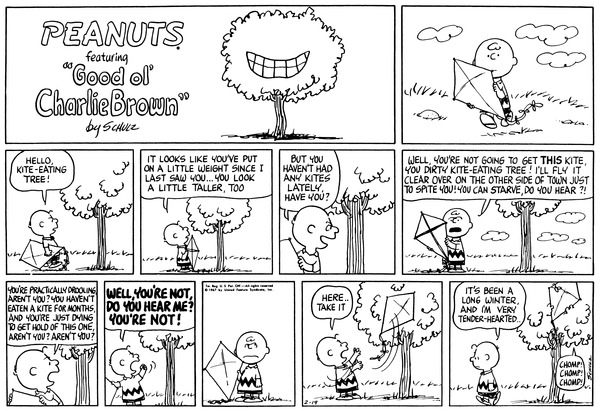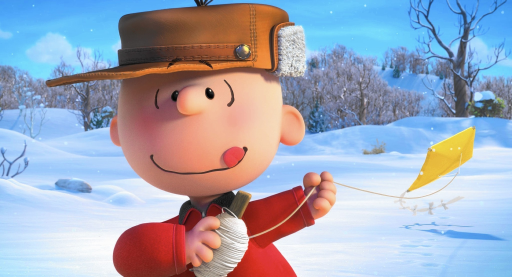I definitely had a negative reaction on hearing about the Peanuts movie. This was one of the big strips of my childhood, along with B.C., Wizard of Id and Garfield. Of course Bloom County, The Far Side and Calvin and Hobbes took over from there, but Peanuts had a fairly special place in my heart. My sister and I bore no small resemblance to Lucy and Linus, it was often noted.
Putting the simple drawings into a 3D CGI format seemed like a disastrous idea, and to be honest, my kids don’t like Peanuts (based on the TV shows) because it’s “depressing”. And it sort of is—certainly, it’s more melancholy than Garfield (though not as existentialist as Garfield Without Garfield), or any modern cartoon or strip.

I’d like to think Jim Davis had this in mind all along.
But for all of modern pop culture’s fascination with “dark” things, Peanuts is probably the best indication that, nah, we just foolin’. Because the underlying message of Peanuts is that, you may—you must!—keep trying, and with failure after failure, you’ll finally discover that, well, you’ve failed again.
But you’ll also discover that life was in the trying.
Charlie Brown doesn’t win, in the material sense: He doesn’t win the baseball game, the hockey game, the football game, he doesn’t fly the kite, he doesn’t achieve scholastically, he’s not good with his hands, he’s not musical, he’s not graceful, and to him, The Girl is aspirational.

I never got the kite-eating tree thing. (Maybe in Schulz’ day they were much harder to fly.) But I loved the notion of a tree actually eating things.
But he does win, because he plays hard. He plays fair. He’s fundamentally decent and kind when all around him are cruel and petty. He does the right thing even when he knows it’s going to hurt, a lot, and he will be reviled for it. Which acts a rebuttal to Glaucon in Plato’s Republic, who demands to know who would behave justly knowing that unjustness gives greater rewards.
Is that pretentious? To bring in Plato when talking about Peanuts? I don’t think so. In fact, there’s an interesting book called The Gospel According To Peanuts that talks about all the Biblical references in the strip. And while Shulz probably didn’t read Republic and think “I’ll show you, Glaucon!” his melancholic worldview stands as convincing rebuttal nonetheless.
Because we like Charlie Brown. And for all his failures, Charlie Brown—I won’t say he likes himself, because that’s too strong—has some sort of inner strength that keeps him going, and on the straight-and-narrow.

Charlie Brown keeps trying after the rest of us have gone in to watch TV.
Surprisingly, perhaps, this movie really captures that. Oh, it’s not as dark as the strip—modern kids wouldn’t accept it, or at least modern movie executives wouldn’t. And in the end, Charlie Brown manages (momentarily, at least) to accomplish a few things that eluded him throughout the movie, including winning the affection of the Little Red-Haired Girl. The latter delivers the most clunky aspect of the film, which is the final exposition saying more-or-less what I’ve said here: That Charlie Brown is decent and pertinacious at every turn, and that is worthy in and of itself.
That’s about half the movie, delivered in an animation style that exploits CGI by forcing it into flat 90-degree angles and maintaining Shulz’ characteristic expressions. There’s no smoothness here, which is really great.

Don’t be fooled by the shading: Note the limited angles used for the characters.
The other half of the movie is about Snoopy vs. the Red Baron, with Snoopy engaging on an imaginary quest to rescue his French girlfriend, Fifi. This doesn’t work as well, at least not for me. And I’m not one of those who believe that Snoopy ruined Peanuts. If you’ve read all the ’50s stuff, you’ll come to appreciate the the ’60s era, with its flights-of-fancy—not just Snoopy, but the living “security blanket” and “kite-eating tree”—gave Sparky a chance to play creatively in great ways. These ways don’t really change the Charlie Brown story. Does it really matter that this was still called “Peanuts” and not “Snoopy and Pals”?
Nonetheless, I found my attention drifting during these parts. The CGI is a bit more florid, which maybe didn’t work as well for me. Note that Shulz did this stuff without a lot of artistic flourish, just like the rest of the strip. A few curlicues for barbed wire, some billows of smoke, stuff like that.

Some of my favorite aspects of the comic didn’t really translate well.
Whatever, it didn’t work great for me.
But the look is great, overall. The voice-acting is great—well, it’s kids, so it’s not always great, exactly, but it’s authentic feeling. Actually, it’s kind of uncanny how close Lucy and Linus sound to the TV originals. The visuals are a mix of dead-on Peanuts humor, and stuff that’s…not…which stand out a bit. Not bad, just very clearly not from the same source. The music is great, too. They kept some Guaraldi, and mixed in a bunch of other stuff, staying away from uber-pop.
The only thing I missed was the Biblical passage, which wasn’t really a thing in the TV/movie realm, except for the Christmas one. Interestingly, they used Violet, a little bit of Shermy (who looks a lot like Schroeder), Frieda (with her naturally curly hair), Franklin (the black kid), and non-Peppermint Patty, who were phased out by the ’60s.
The Barbarienne loved it, ranked it up there with Tangled or Frozen or whichever her favorite princess movie is. The Boy also really liked it, after expressing his initial reluctance toward seeing it. The Flower wanted to go see it, but she had spent the weekend testing for her high school diploma, so her eyes were tired of looking at screens.
It’s probably not for you if you’re a hardcore purist, but I think the presence of members of the Shulz family on the writing team had a big influence on keeping things pretty close to home.
Not nominated for an Oscar.

Rats.
